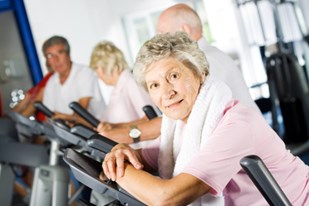Managing blood sugar can be complicated for people with diabetes. It involves eating the right foods, testing blood sugar, and taking medications as instructed. Another way to help control blood sugar levels is through exercise. While exercise may not be your aging relative’s favorite thing to do, it’s important that you encourage them to be physically active.

How Exercise Affects Blood Sugar
Exercise helps to control blood sugar in two ways:
- It makes the body’s cells more sensitive to insulin. This makes the cells in the muscles more effective at using insulin to pull glucose into the cells to be used for energy.
- During exercise, muscle contractions make it possible for muscle cells to draw in glucose even when insulin is not available.
These effects occur each time a person exercises. So, when your aging relative exercises regularly over time it can lower their A1C.
Other Benefits of Physical Activity
In addition to helping the body use glucose for energy and lowering blood sugar levels, exercise has many other health benefits. According to the Centers for Disease Control and Prevention (CDC), some of the benefits of exercise are:
- Weight loss, if needed.
- Staying at a healthy weight.
- Improved mood.
- Better sleep.
- Improved memory.
- Managing blood pressure.
- Controlling cholesterol levels.
How Much Exercise is Needed?
The CDC says adults should get a minimum of 150 minutes of moderate-intensity exercises each week. That equates to 20 to 25 minutes each day, or 30 minutes 5 times a week. It’s also important to engage in exercise that uses all of the major groups of muscles.
Some moderate-intensity exercises your aging relative could try are:
- Going for brisk walks.
- Cleaning the house.
- Cutting the grass.
- Swimming.
- Dancing.
- Bicycling.
Before your aging relative begins a new exercise routine, it’s important to talk to their doctor to make certain they are healthy enough. Once they are cleared to exercise, encourage them to start slowly. For example, try starting with just a short walk and working up to longer walks as their health improves. If they are reluctant to exercise, finding an activity they enjoy can make the idea more appealing. Exercising with a friend can also make it more fun.
Home care can also encourage your aging relative to be more physically active. Sometimes older adults don’t exercise because they are afraid they may injure themselves. Having a home care provider present can make them less afraid because they know there is someone to help them if needed. In addition, home care providers can go for walks with the older adult and keep them from falling. If your older family member prefers group fitness classes, a home care provider can drive them to the gym.
Sources
https://www.cdc.gov/diabetes/managing/active.html
http://www.diabetes.org/food-and-fitness/fitness/get-started-safely/blood-glucose-control-and-exercise.html
http://www.diabetes.org/food-and-fitness/fitness/physical-activity-is-important.html
